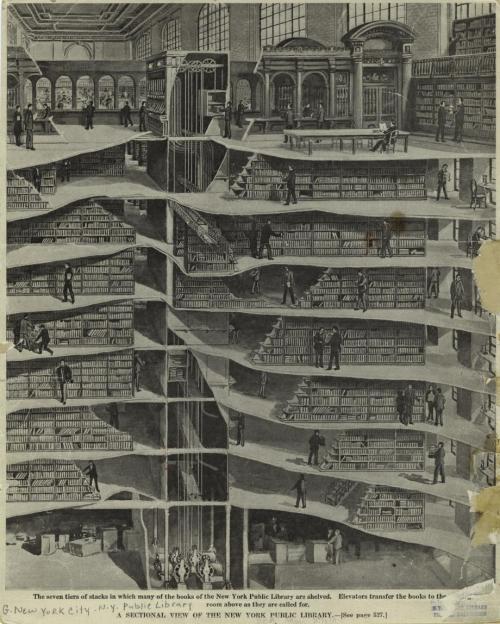'100 famous views of Edo'
(Meisho Edo Hyakkei)
Ukiyo-e woodblock print series
by Utagawa Hiroshige (Ando), 1850s
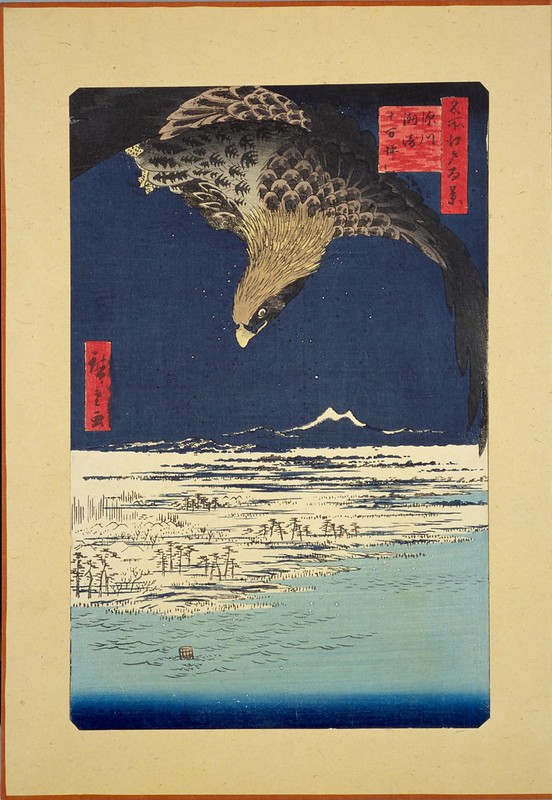
Fukagawa Susaki and Jūmantsubo
"This view looking northwest from Fukagawa Susaki, a spit of land along Edo Bay, toward Jūmantsubo, a tract of land named after its approximate area of one hundred thousand tsubo (about eighty acres), is one of the most dramatic designs of the series. Its appeal lies in the contrast between the powerful form of the eagle as it prepares to dive for prey and the desolate wintry marshes below. As in other views devoid of people, there is still a pervasive human presence—in the roofs huddled to the left, in the poles of the lumber-yards beyond, and, above all, in the lone wooden bucket floating at the edge of the bay, surrounded by water birds on which the eagle seems to have its eye." [
source]

Night View of Sarukawa-machi
"As the full moon rises high in the autumn sky, its rays bathe Saruwaka-machi, the theater district of Edo, with silver light. The moonlight also displays an array of shadows that seem to have a life apart from the gray and black figures that cast them. These shadows are central to the magical quality of this unusual print. Both for Western viewers accustomed to pictures with shadows and for Edo viewers to whom shadows were a curiosity, these particular forms have the similar effect of conjuring up an otherworldly atmosphere." [
source]
"Sarukawa-machi was known as a theatre district in Edo (Tokyo). Three official Kabuki theatres on the right side are identified by turrets of boxes known as Yagura, with the crest of approval at the entrance. It is already late in the evening and the theatres are nearly closed, as the tea houses across the road have put on bright lanterns to guide their guests back to the gate. A palanquin waits beside one of the tea houses. At the top of dark sky mika was used to give a glittering impression of the evening sky."[
source]

Kitsunebi on New Year's Night
under the Enoki Tree near Ōji
"Hiroshige drew his subject matter from folklore as well as from poetry, literature, and history. This image depicts the legendary explanation for the luminescence known as foxfire, observed at the Inari shrine at Oji. According to folklore, ghostly foxes gathered at the nettle tree near the shrine on New Year's Eve. The number of lights (each one a fox) was thought to predict the abundance of the harvest in the coming year. The nettle tree in the print actually existed and was cut down early in this century." [
source]
"In the late 1850s, while Japanese color prints were dominated by themes of the fantastic, Hiroshige emphasized the realities of the observed world in his work. However, here he has ventured into the world of spirits. It was believed that on New Year's Eve all the foxes of the surrounding provinces would gather at a particular tree near Oji Inari Shrine, the headquarters of the regional cult of the god Inari. There the foxes would change their dress for a visit to the shrine, where they would be given orders for the coming year. On the way, the animals would emit distinctive flames by which local farmers were able to predict the crops of the coming year." [
source]
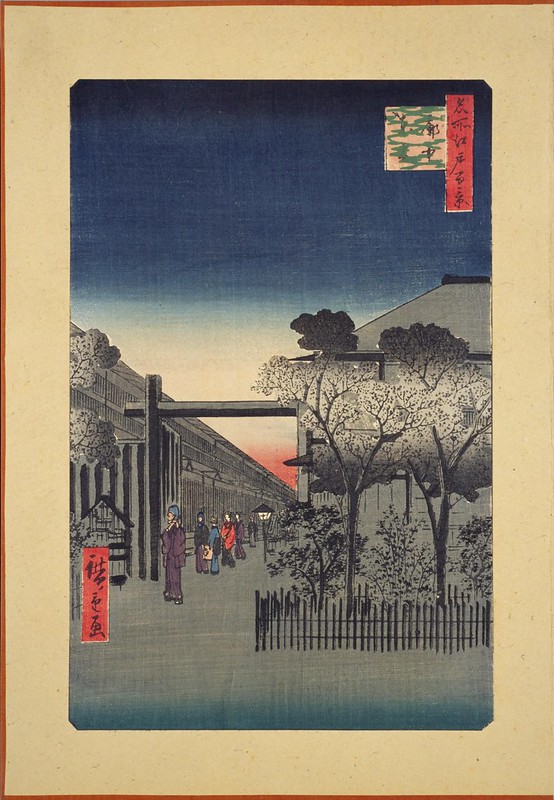
Dawn in Yoshiwara
"Daybreak had classic associations in Japanese literature with parting lovers, and the scene played out by the four figures at the center of this print is in keeping with that tradition. It is early dawn in the Yoshiwara, the popular licensed pleasure quarters for the Edo demimonde. To the left is a departing guest, his "cheek-cover hood" discreetly in place for the journey home. An attendant to the rear seems anxious to return to bed, while another one with a lantern stands in front of the guest, facing awkwardly away from him and toward the courtesan, who is clad in a bright-red overgarment and wears raised black clogs that mark her high rank." [
source]
"From the dark and cold winter to the fresh and sparkling spring. Here Hiroshige has placed the viewers in a strangely evocative zone of transition, as dawn breaks in the Yoshiwara licensed quarter. The cherries, a peculiar Yohiwara’s institution, are in flower. Every year, for the brief duration of their spectacular bloom, they were temporarily transplanted to a raised bed of soil and then whisked away. The place is one of the several side streets leading out into the central avenue. To get out of the Yoshiwara’s enchanted world, one must make a turn: to the left from our point of view, toward Ômon Gate, the one point of entry and departure for visitors. The lead figure we see here is probably going home and therefore heading to the Gate. The smaller figures behind him are: a high rank courtesan wearing raised black clogs and her guest (to the left). The two other figures are two attendants that are escorting the couple through the darkness. Daybreak had classic associations in Japanese literature with parting lovers." [
source]

Cherry Blossoms on the Banks of the Tama River
"The "Tama River," actually the Tama River Aqueduct, carried much of the drinking water for the city of Edo along a thirty-mile course. Hiroshige's springtime view vividly conveys a freshness and vitality befitting this lifeline. The cherry trees were planted along much of the embankment in the 1730s. The placement was not only aesthetic but also practical: the trees' roots strengthened the banks, and their petals and leaves were thought to possess antitoxic powers that kept the water pure. [..]
The Tama River Aqueduct shown here was constructed in 1653-54. It carried drinking water for the city of Edo along a 30-mile course, and continued to carry much of the water supply for the city of Tokyo until the 1960's. Then the old Edo wooden system was replaced with modern equipment and this part of the canal, no longer needed, was paved over. The cherry trees along the embankment were planted in the 1730's and were not only a source of beauty, but helped to keep the water pure through the allegedly antitoxic powers of the leaves and petals. To the left is the entrance to one of the smaller samurai estates. In the Edo period, most of this park was the estate of the Naito clan, lords of Takata; subsequently, it served as an agricultural college, a private imperial garden and since 1949 as a public park. The two-story buildings mark the Naito Shinjuku settlement, where one can see a customer and thee "serving girls" as they were known, in the rear quarters of a brothel to the right of the canal." [
source]
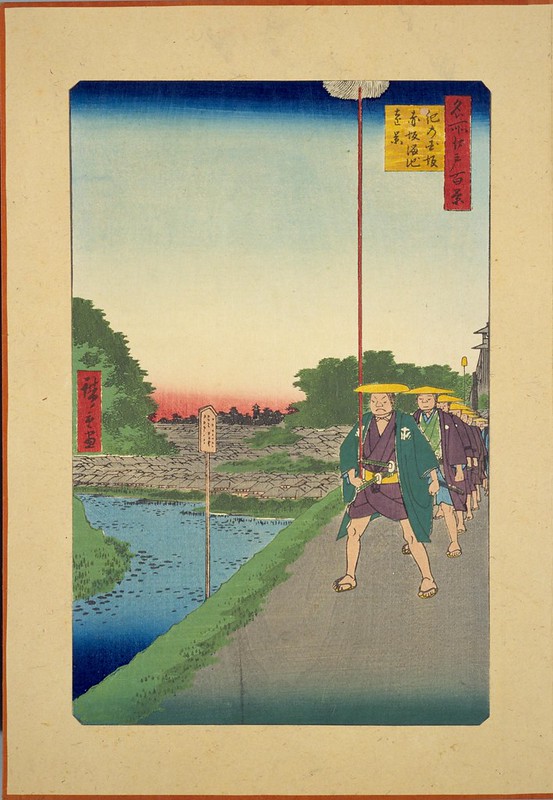
Kinokuni Hill and Distant View of
Akasaka and the Tameike Pond
"The forward guard of a procession of samurai comes strutting up Kinokuni Hill with the Akasaka district in the distance. He wears a stern expression, intent on balancing in the palm of his hand a tufted standard that he would from time to time twirl and toss in the air. Some commentators have faulted Hiroshige for the downhill appearance of this uphill slope, but he is merely setting the stage for the performers. The figures probably belong to one side of a double-file procession, marching in a rhythmic goose step that is only hinted at by their tense posture. [..]
This view shows a daimyo procession marching up Kinokuni Hill, with Akasaka district in the distance. Shown here is only one side of a double file procession. These figures were well known for their performing skills, twirling and tossing these standards, which are seen well balanced in the palms of their hands. The forward guard is wearing a jacket of indigo-dyed "shobu leather," named after the pattern of shobu leaves (seen also in print 64 of the series) on the shoulders. Kinokuni Hill ran outside the estate of the Tokugawa lord of Kinokuni (Kii Province, now Wakayama Prefecture). The Kii estate became Akasaka Detached Palace in the Meiji Period, then was the residence of the emperor until 1888. In 1909 it became a grand Western-style palace that remains there today and is now used as a state guest house. At the lower left is a section of the Outer Moat, known today as Benkeibori. In the far center distance is a fire tower and shogunal firefighter barracks, which today is the Hotel Okura Annex. Behind the procession, in the forest, is one of the estates of Asano of Hiroshima, which in modern times has been a military court, a prison, a barracks, and today is the site of the TBS broadcasting empire. At the far right is another fire tower of another shogunal barracks." [
source]

Plum Orchard in Kamada
"The entire Kamata area south of Ōmori was known for the cultivation of plum trees and was celebrated more for its early summertime fruits than its springtime blossoms. The gentle beauty of this print tends to distract the viewer from the structure intruding from the right. It is a cushioned palanquin known as a yamakago ("mountain palanquin"), once widely used for travel in Japan. The overgarment left casually on top suggests that a traveler has recently stopped off for a brief rest from the nearby Tokaido highway that linked Edo to Kyoto. [..]
View of the extensive Plum Garden in the Kamata area. The estate which was open to the public complete with teahouses and a restaurant dated from the early Bunsei Period (1818-1830) and came to be known as the "Plum Mansion" (Umeyashiki), with its several hundred trees extending into the distance. The owner of the mansion was a medicine dealer from Omori, whose chief product was a cold remedy called Wachusan. The structure on the right is an indigo cushioned palanquin of the simple A-frame type known as a "yamakago" ("mountain palanquin") and was used widely for travel in Japan, suggesting that a traveler had stopped off from nearby Tokaido for a rest, leaving an over garment on top." [
source]
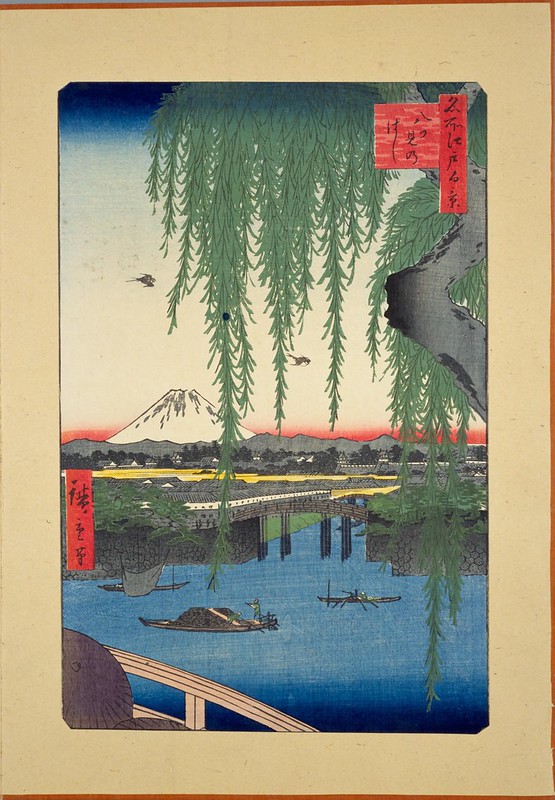
Yatsumi Bridge
"Although Yatsumi Bridge literally means "Eight-View Bridge," a more accurate translation would be "Eight-Bridge View" since from it one could see eight different bridges, including Yatsumi itself, on which the viewer is standing. This bridge was one of the busiest in Edo and joined the mouth of the Nihonbashi River with the outer moat of Edo Castle. So heavily traveled was the bridge that its southern approach served as the site of a stone post on which notices of lost children were pasted. The only allusion to this bustling site in an otherwise placid scene is the two parasols moving along at the lower left. [..]
A luxuriant willow frames the upper right of the placid scene, its elegant branches drooping low into the composition. Below, two men slowly pole a boat stacked with kindling while solitary fishermen, their boats tied to anchor poles, dip square nets into the shallow water. In the middle distance, Edo Castle stretches the width of the view, and Mount Fuji lies on the horizon with its customary majesty. A pair of swallows gracefully course in the summer sky. If we had actually been standing at the viewpoint Hiroshige has created, we would have experienced a bustle that the artist only alludes to in the two parasols moving across the bridge at the lower left. This is Ichikoku Bridge, one of the busiest in Edo, where the mouth of the Nihonbashi River joined the outer moat of the castle. So heavily traveled was the bridge that its southern approach served as the logical site for a stone post to which notices for lost children were pasted; the post which survived at the site today is dated 1857, one year after Hiroshige's view was published. Yatsumi Bridge, the alternate name of Ichikoku Bridge that is used in the title, literally means "Eight-View Bridge," but it more accurately translated 'Eight-Bridge View," since from this point fully eight different bridges were visible- including the one we are standing on. Two more may be seen in this view - Zenimake Bridge in the foreground and (barely) Dosan Bridge beyond. Out of sight are Tokiwa Bridge to the right , Gofuku and Kaji Bridges to the left, and Nihonbashi and Edobashi Bridges (see print 43 of the series) directly behind us. This scene is utterly transformed today. The moats to left and center have been filled in, and the curve of the Nohinbashi River lies in the shadow of an elevated highway. The purplish horizontal streak in the center of Hiroshige's view is now Marunouchi, Tokyo's central business district. It is hard to believe that it was actually possible to fish here, in the very center of the city." [
source]
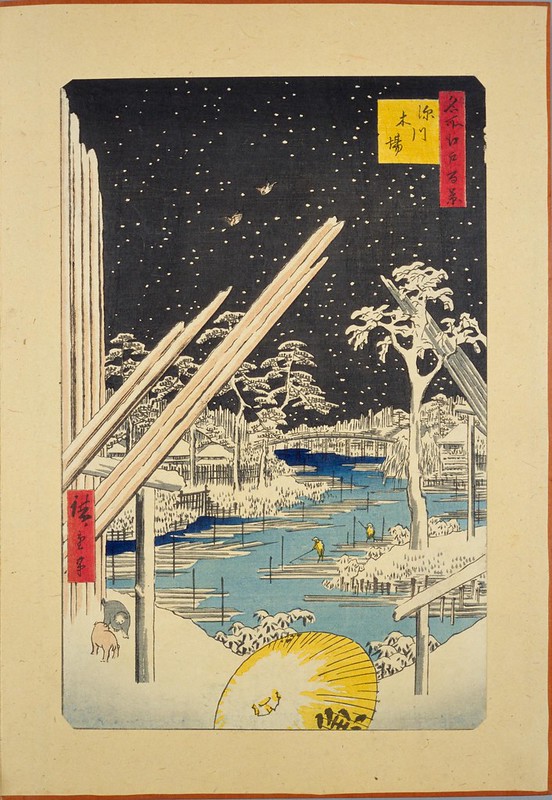
The Fukagawa Lumberyards
"The Fukagawa lumberyards, site of part of the huge supply of lumber needed by the world's largest wooden city, were of great economic importance. In early Edo, lumber was kept closer to the center of town. However, in the wake of a fire in 1641 that destroyed not only houses but the lumber needed to rebuild them as well, the government ordered the yards removed to the Fukagawa district. The snow falling on the water here provides one of the brightest images of winter in the series. [..]
After the fire in 1641 which destroyed both houses and the lumber needed to rebuild them, lumberyards were removed to the Fukagawa district, east of the Sumida River, to the place officially named Fukagawa Kiba ("wood place"). In this scene one sees the leaning poles, two sparrows, two loggers, two puppies, and at the bottom, a yellow umbrella which has the "fish mark" of the publisher Uoei. The lumber was transported to and from the Kiba lashed onto rafts and poled by skilled loggers, two of whom are seen here wearing straw capes. The Fukagawa lumberyards survived until the mid 1970's when the land began to subside, obstructing the passage of the lumber boats. Today, much of Tokyo's lumber arrives by ship from all over the world and is then transported by truck. However, Kiba survives as a place name." [
source]
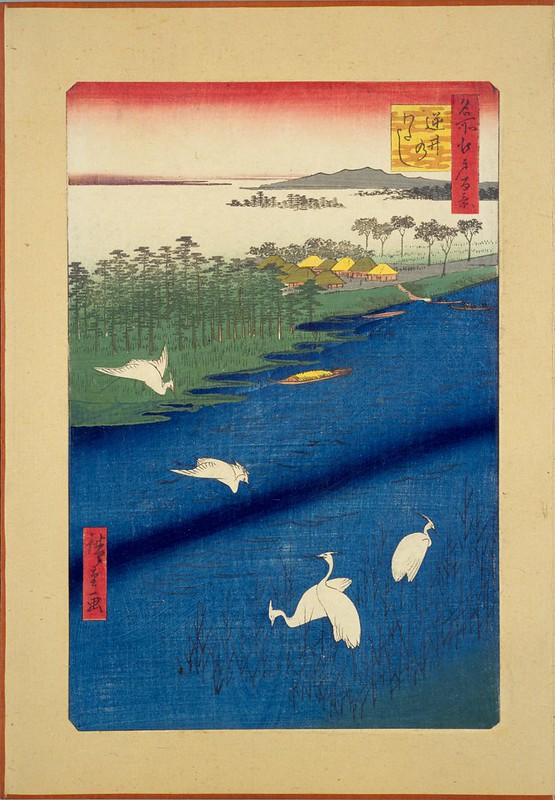
The Ferry at Sakasai
"The birds that dominate this scene in the swampy delta area around the village of Sakasai east of Edo have been accorded special attention, with their wing patterns executed in delicate karazuri embossing. Judging from the bushy crests and yellow bills, the birds are Chinese egrets—a species only rarely seen in the summer in Japan. Far more common was the little egret, with no crest and a black bill. The artist naturally preferred the more decorative species, whether it was to be found in the place or not. [..]
The center of attraction here are the Chinese egrets, with their bushy crests and yellow bills, that are shown inhabiting the Nakagawa River. In the distance is a lone cargo boatman and two ferries passing each other near the landing. The Sakasai ferry was named after the neighboring village on the far side and was replaced by a Sakasai Bridge in 1879, the first bridge built across the Nakagawa. The Chinese egrets, shown here, were rarely seen in the summer in Japan and today egrets of any type are rare in this densely settled part of Tokyo." [
source]
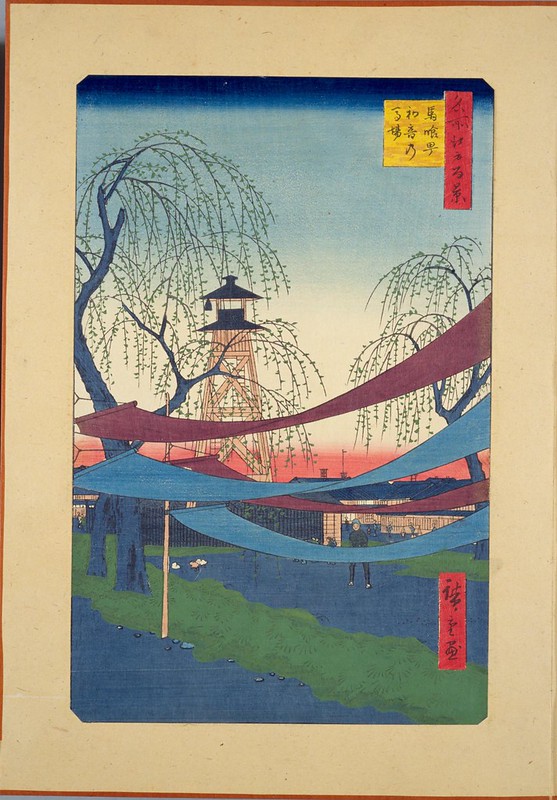
Hatsune Riding Ground in Bakuro-chō
"The three colorful strips of cloth in the foreground of this print are not celebratory banners but bolts of cloth that dyers have hung out to dry. Hiroshige emphasizes the cloth's materiality by embossing a textured weave pattern on the surface of the white bolt. In the distance stands one of the many fire-watch towers scattered throughout the city. The buildings below were largely devoted to lodging visitors to Edo, maintaining the long-established function of this site as a point of entry and departure for travelers from the north. [..]
Spring scene of the open space known as Hatsune no Baba, located in downtown Edo not far from Asakusa Gate. This space was originally a horse-riding grounds (baba) for practice by the shogun's retainers, the oldest of several such in Edo (see Pl. 115 for another). By Hiroshige's time, however, it no longer played a role in the defense of Edo but was now retained as an idle space in a crowded part of the city, with willows planted around its perimeter. This print provides evidence that dyers from Kon ya-cho, several blocks to the west (see Pl. 75) had taken to using the space for drying their cloth, three blots of which are strung between posts in the foreground. In the background to the left is a watchtower for fires. The buildings below are largely devoted to lodgings for visitors to Edo, maintaining the long-established function of this site at a point of entry and departure along the Oshu highway for travelers from the north. The open area, besides being used for drying newly dyed cloth, was also used at night by nearby match makers for testing the quality of their sulphur. Difficult to see in reproduction is the textured cloth pattern on the white strip of cloth, created by a technique known as nunome-zuri, "fabric-printing." This technique was used frequently in the first paintings of the "One Hundred Famous Views of Edo," most commonly in the title cartouches, but also as here when actual fabric was depicted. It was achieved by pressing a piece of silk into the moistened paper, leaving the pattern of the weave delicately embossed on the surface." [
source]

Scattered Pines on the Tone River
"We can almost hear the swish as the fisherman casts his net out over the Tone River. The stubby lead weights around the edge of the net form a pleasing border to the intricate web within, a masterpiece of carving technique. Through the net is a blurred continuation of the distant shore. The "scattered pines" of the title may be explained by the pine trees on the island at the left, worn and twisted by the wind. The place was popular among fishermen for its carp. [..]
This scene shows a fisherman casting his net, with lead weights around the edge, into the Tone River. The location depicted was known for its carp and the wind twisted pine trees mentioned in the title appear on the shore to the left. In Hiroshige's day, "Tone River" referred to what is now the Edogawa River. It has been suggested that the "Barabaramatsu" in the title referred to more than one place, perhaps various groups of scattered pines along the riverbanks in this region." [
source]
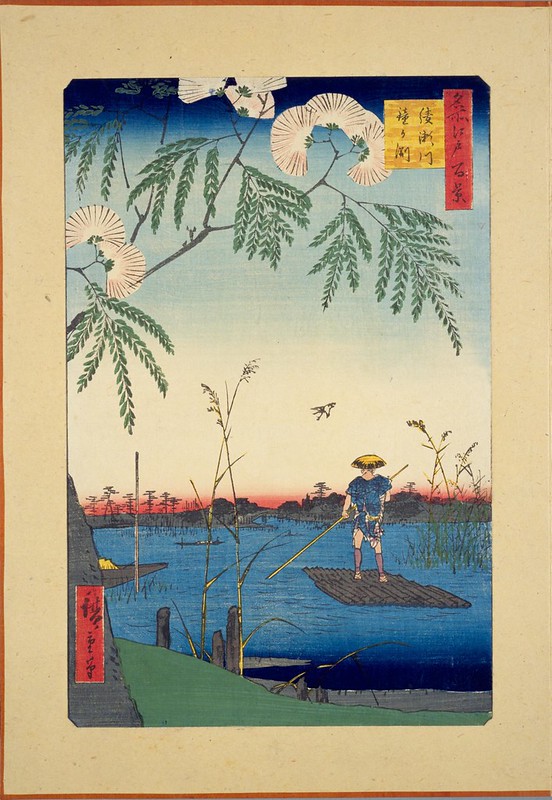
The Ayase River and Kanegafuchi
"Here we reach the farthest point north in the progression along the Sumida River that began in number 55. The view is from the west bank, looking across to the northeast at the point where the Ayase River flows into the Sumida. This isolated site, called Kanegafuchi, was known for the planting of silk trees, a kind of mimosa, along the bank. Hiroshige has framed the view with one of the trees in full bloom. The silk like filaments that give the tree its name are expressed in light pink lines accented with black. Beyond is a boatman whose bold garment echoes the pattern of the blossoms. [..]
This view looks at the point where the Ayase River flows into the Sumida; due to its curve and convergence with the Ayase, the water here was deeper and the flow more rapid than elsewhere on the Sumida. The story is told of a temple bell which fell into the river during a flood, sinking to the bottom and giving the name Kanegafuchi, "bell depths" for the stretch of the river. This location was also known for its silk trees, a kind of mimosa, growing along the bank. This scene shows one of the trees in full bloom with its silk like pink flowers accented in black. The boatman below is dressed in a bold patterned garment and a heron flies above the reeds. In 1887 the Kanegafuchi Spinning Company was constructed on the south bank of the Ayase River (the area to the far right), a joint venture of five Tokyo cotton-thread dealers, known as "kanebo." In time it became Japan's largest cotton-spinning firm and has since diversified into cosmetics." [
source]
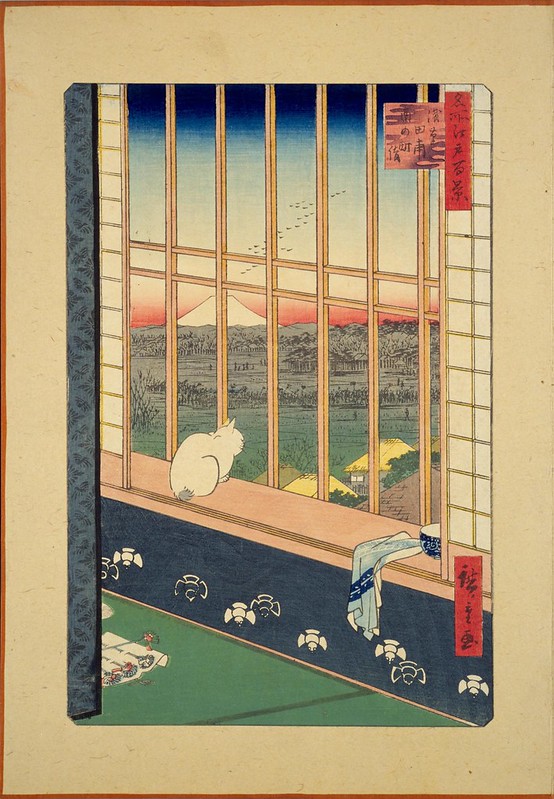
Asakusa Rice Fields and Torinomachi Festival
"Hiroshige here presents the Yoshiwara pleasure quarters on the single busiest day of the year. However, from the second story of a brothel, the noise and activity seems far away. In the distance, crossing the Asakusa Ricefields, is a procession celebrating the Torinomachi Festival. On this day, the Yoshiwara was open to everyone, including ordinary women. It was also a monbi, one of the special days on which each courtesan was required by tradition to take a customer—or to pay the fee to the brothel owner if she failed. Casually arranged in the foreground are a courtesan's accouterments. Peeping out from behind the border of a screen are tissue papers delicately known as "paper for the honorable act." [..]
This image offers a view from the second story of a Yoshiwara brothel over the Asakusa Ricefields, toward a dense procession of visitors to the Torinomachi Festival, held at Washi Daimyojin Shrine (to the right - not seen here). The god of this shrine is an eagle (washi), popular among those in the entertainment trades. Particularly popular during the festival were "kumade," bamboo rakes decorated with symbols of prosperity offered at the many stalls in and around Washi Shrine. It was the only time ordinary women were allowed to enter the gates to the Yoshiwara. It was also a "monbi," a special day on which each courtesan was required by tradition to take a customer, or pay the fee to the brothel owner if she failed. It was the single busiest day of the year in the Yoshiwara. This scene shows the room of a courtesan who has just had an afternoon customer. He probably brought her as a gift the set of "kumade" hairpins, one of which has been pulled out and admired. On the window sill is a mouth-rinsing bowl and a used towel; to the left is the border of a folding screen decorated with a bird motif, and just above the hairpins is a parcel of tissue papers delicately known as onkotogami, or "paper for the honorable act." In the foreground is an exquisitely detailed cat." [
source]

Mount Atago in Shiba
"Hiroshige dramatically interrupts this view from Mount Atago in the district of Shiba southwest of Edo with a figure holding an immense rice paddle. The inscription over the artist's signature to the left identifies the figure as the central actor in the "Heaping Rice Ceremony" performed at the Atago Shrine on the third day of the New Year. In real life, this man was the proprietor of the Atagoya teahouse at the top of Mount Atago. Here however he is dressed in an elaborate costume emblematic of the New Year and of prayers for its bounty. [..]
Scene of the "Messenger of Bishamon" on this third day of the New Year. He is the central actor in the "Heaping Rice Ceremony" performed at the Atago Shrine, dressed in a costume designed for the new year. In real life, he is the proprietor of the Atagoya teahouse at the top of the hill. He wears a ceremonial robe over which are draped strips of kelp which will later be chopped up and according to custom be distributed to shrine believers for the making of a tea guaranteed to ward off colds. He is wearing an upside-down basket on his head, with a citrus fruit and a helmet ornament. Strips of sacred paper are draped from the neck and he is holding an immense rice paddle, all tokens of the martial spirit of Bishamon-ten (one of the four guardian deities of Buddhism as well as one of Japan's Seven Gods of Happiness). At the end of the ceremony, the messenger descends the eighty-six stone steps at the foot of the hill, and greets the clergymen there who are eating from "heaping rice" bowls. Striking his giant paddle, he instructs his audience, "eat, eat." After their reply, "we will, we will," he returns up the steps and re-enters the gate of the shrine. (By custom he was required to walk balanced on high single-toothed clogs.)" [
source]

The Sumiyoshi Festival at Tsukudajima
"In the middle distance, a chanting mob of young men carries the sacred palanquin of the Sumiyoshi Shrine through the shallow flats surrounding the island of Tsukudajima. The giant banner in the foreground bears the inscription "Sumiyoshi Daimyōjin," an honorific title of the shrine deities, with the names of donors below. The smaller inscriptions to either side provide the date and the name of the calligrapher, Seikengū Gengyo. This is none other than the poet and artist Baisotei Gengyo, the designer of the Table of Contents for this series. [..]
A group of men are carrying the sacred palanquin of the Sumiyoshi Shrine though the water encircling the island of Tsukudajima, at the mouth of the Sumida River. The tiny island of Tsukudajima was claimed by a group of thirty-four whitebait fishermen in 1645-46 who brought with them the name Tsukuda and their local Sumiyoshi divinity, the protector of mariners and fishermen. The festival commemorating this move was held on the twenty-ninth day of the Sixth Month in 1646 and every third year thereafter - including the year in which this print appeared. The celebration of this festival continues today, although the practice of mizu togyo (carrying the shrine through the water), discontinued in 1963. The giant banner in the center is inscribed in archaic script "Sumiyoshi Daimyojin," and the smaller inscriptions to either side show the date and the name of the calligrapher, Seikengu Gengyo, who is the poet and artist Baisotei Gengyo who designed the Table of Contents for this series. The date on the banner is just one month earlier than the publication of the print itself. The banner still remains in the treasury of the Sumiyoshi Shrine. On the right-hand side is a section of a red festival shrine lantern." [
source]
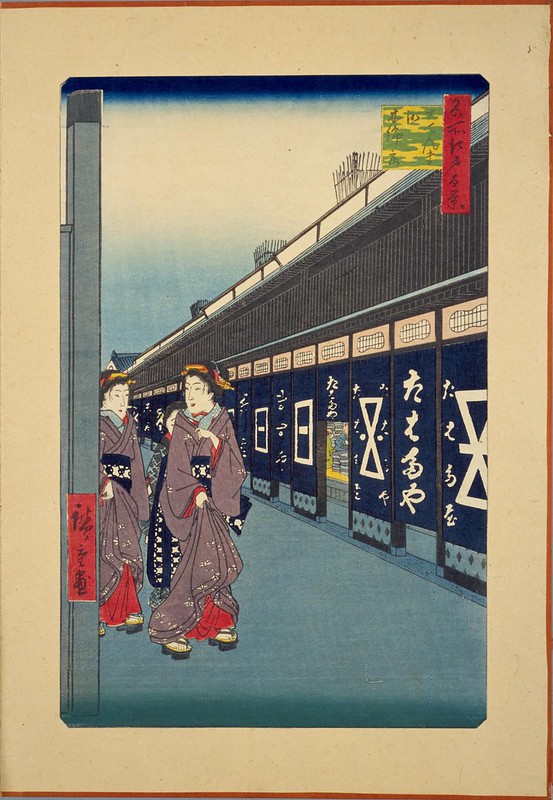
Shops with Cotton Goods in Ōdenma-chō
"Here we see a boisterous procession of carpenters, among the most powerful artisans in Edo, a city built of wood. To the left is the great dry-goods house of Daimaru, in the prosperous district of Ōdenma-chō, suggesting the interlocked fortunes of Edo merchants and Edo builders. The shop sign to the upper left bears the slogan "Cash payment, prices as marked." This practice, established in Japan as early as 1683, broke down the traditional class-based relationships between seller and buyer, making all customers equal. [..]
This boisterous procession is called "sending off the master carpenter" (toryo-okuri) and it followed the ridgepole-raising ceremony for a new building. Since most of the structures in Edo were built of wood, fires were frequent, rebuilding was constant, and the carpenters were among the most powerful artisans in the city. The ceremony lasted several hours, beginning with rituals conducted by a Shinto priest on a platform atop the roof of the newly framed structure, on which the symbolic items, seen here on a pole, were displayed. This sacred pole has cloth strips of five colors, paper "gohei" above, in between three fans with the rising sun symbol surrounding a mirror, below women's hair accessories, said to be symbolic of the sacrifice of a young maiden at the beginning of a large building project. Next came two ceremonial "exorcising arrows," and on the arrows are mounted large carvings of the crane and the tortoise, symbols of long life. The chief carpenter is leading the procession and he is followed by the construction bosses, each in mock samurai ceremonial dress. After the rituals, the homeowner provided a banquet with plenty of drink. The marchers, seen with open mouths, are singing a work song. In this prosperous district of Odenma-cho, at left, is the well-known dry goods store Daimaru. The storefront of Daimaru is shown in careful detail, suggesting the idea of mutual prosperity. Daimaru was a branch of a Kyoto establishment, founded in 1717 by Shimomura Hikouemon (whose family name appears on the sign here) and expanded to Edo in 1743. The shop sign to the upper left says "cash payment prices as marked"; marking fixed prices on merchandise was a practice first established in Japan as early as 1683 and Daimaru followed competitively. It has been said that fixed pricing made all customers equal and that an egalitarian mass society had begun to emerge in Edo far earlier than anywhere else in the world. Today Daimaru continues to thrive at its new location, right over the east entrance of Tokyo Station." [
source]

Suidō Bridge and the Surugadai Quarter
"Without the three immense carp banners, this view would have been a classic depiction of samurai Edo, looking southwest over the densest single concentration of samurai households in the city, from Surugadai on the left through Banchō in the distance. The banners and streamers indicate that the time is the Boy's Festival, the fifth day of the Fifth Month. The three carp are standards used by commoners in imitation of the military streamers, which they were prohibited from flying. The banners drew on a Chinese legend of a fish so strong that it could leap a waterfall—an image considered appropriate for young boys. This view thus seems to depict witty merchant-class mimicry of the samurai version of the Boy's Festival. [..]
This view celebrates the Boy's Festival, which takes place the 5th day of the 5th month. The scene looks across the Kanda River, over the expanse of the densest single concentration of samurai in the city, extending from Surugadai on the left through Bancho in the distance. A samurai procession passes over the Suido Bridge in the lower right. The tall banners, known as "fukinagashi" (military streamers) and the vertical "nobori" banners with portraits of Shoki, the Demon Queller of Chinese legend indicate the time is the Boys Festival, the fifth day of the fifth month. It should be noted that the designation of the month "i5"/1857 shown above, indicates that it was an extra or "intercalary" month inserted to let the calendar catch up. It was a practice for each of the samurai households to fly the banners shown here, celebrating a boy of age six or seven. The three large carps, by contrast, are marks of the "choinin" city and were used by comers for the Boys Festival imitating the military "fukinagashi," which they were prohibited from flying. According to Chinese legend, the paper and later silk carps signify a fish so strong and persistent that it could leap a waterfall. As noted in the Introduction to this series, Hiroshige himself was of samurai origin, a genuine hereditary retainer of the shogun, qualified to wear two swords and to hold formal office within a bakufu fire brigade until age thirty-six. The center shows a black free-standing fire tower. Hiroshige was undoubtedly familiar with this part of town." [
source]

Shitaya Hirokōji
"This print depicts a fascinating array of customs. In the immediate foreground are three samurai, identifiable by their double swords but unusual for their Western pants, a recent import popular among younger samurai. The identical parasols, uneven procession, and diverse dress of the women ahead mark them as a group of merchant-class tourists. They are on their way to view the cherry blossoms hinted at by the rosy-tinged cloud in the distance. [..]
Busy street looking down a long row of shops with a detailed depiction of one particular store, in this case, the silk store "Ito Matsuzakaya" and two delivery men bearing large packs with the shop crest. The site today is still occupied by Matsuzakaya, which like Mitsukoshi (pl. 8) has become one of Tokyo's major department stores. The subway stop in front is now called Ueno Hirokoji, and the tradition of a broad pedestrian space continues in contemporary Tokyo. In the immediate foreground there is a group of three samurai, identified by their two swords but unusual in the Western pants they wear; these were a recent import that spread rapidly among younger samurai for their distinctive style and ease of movement. (This series was begun three years after Admiral Perry "opened" Japan.) A large group of women carrying red parasols are probably students at some school of chanting or dancing, on their way to view the cherry blossoms at Kan'eiji, followed by a group of men carrying the appropriate refreshments. The small building just to the right of the head of the procession is a barbershop, where class status was marked above all by hair style. A bank of stylized clouds, comparable to the clouds in the preceding print, hangs over the forested mass of the temple beyond." [
source]

Senju Great Bridge
"Senju Great Bridge was originally known as the Great Bridge as it was the only bridge over the Sumida River, (known here as the Arakawa River - or even more locally as the Senju River) until the Ryogoku Bridge was completed in 1661. Senju Great Bridge was not only the first bridge across the Sumida but it also survived the longest, due to its sturdy construction and rot-resistant timber supplied by the lord of Sendai, the most powerful daimyo to use the bridge regularly. Senju Great Bridge, built in 1594, finally washed away in the great flood of 1885. The buildings on the far side of the river are part of the Senju settlement, the first official post town on the road to the north. It was one of Edo's four post stations, together with Shinagawa (shown in print 83 of this series), Naito Shinjuku (print 86), and Itabashi. The mountain in the distance is thought to be Mount Buko." [
source]

View of Nihonbashi itchōme Street
"It is a hot summer day in the middle of the Main Street of Edo in the bustling Nihonbashi district, and almost everyone hides under a hat or a parasol, intent on avoiding the sun. Under a huge two-tiered parasol is a group of dancers who performed celebratory shrine dances for donations. Called Sumiyoshi dancers because of their origin as seasonal minstrels from Sumiyoshi Shrine near the city of Osaka, they had evolved by Hiroshige's time into native Edo street performers. Following them is a different sort of street minstrel, from the outcast hinin class. Such women sang songs accompanied by the samisen, a lute-like instrument, and were always escorted at a distance by a husband or a father. [..]
This scene is in the middle of the main street in Edo, on a hot summer day; most of the people are under hats or parasols to escape the sun. The older man on the right is eating a yellow Makuwa melon and beyond him to the left, a delivery boy is almost hidden by his tray load of noodle boxes from the sboa shop Tokyoan (the white noren in center). A group of Sumiyoshi dancers are under a huge two-tiered parasol. Originally, the Sumiyoshi dancers were seasonal minstrels from Sumiyoshi Shrine, near Osaka, who would perform celebratory shrine dances in return for donations. The five dancers here are wearing their costumes of straw materials, red aprons, white fans and sedge hats, topped by the blue parasol with red shashes and white "gohei." Following the dancers is a female street minstrel, the "onna-dayu," who along with others would sing to shamisen accompaniment. The onna-dayu were from the outcast "hinin" class and were always followed at a distance by a husband or father. It was suggested by Miyao Shigeo that this woman following the Sumiyoshi dancers might be their samisen accompanist. The street scene here is the cotton sellers district, occupied by merchants from the Omi region. The Sumiyoshi dancers were traditionally dressed in cotton; the onna-dayu were prohibited by class barriers from wearing silk but were known for their stylish cotton kimonos, as seen here, closely fitted and wearing high "geta" clogs. The large store to the right is Shirokaya, founded in 1662 and one of Tokyo's great modern department stores, now part of a Tokyo chain." [
source]
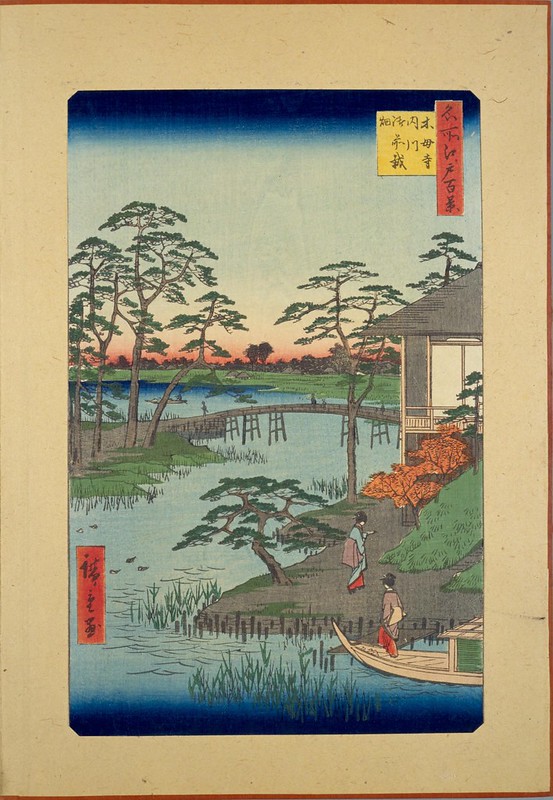
Mokuboji Temple and Vegetable Fields
on Uchigawa Inlet
"Two well-dressed ladies disembark from the boat by which they have traveled up the Sumida River into the inlet known as Uchigawa. Their destination is one of Edo's famous suburban restaurants, seen in the upper right. Located within the precincts of Mokuboji Temple, which lies out of sight to the right, it specialized in dishes of taro and clams and was much prized among stylish residents of Edo. The area to the left with pines was known as Gozensaihata, or "The Honorable Vegetable Garden." Beginning in the 1650s, fresh vegetables for the shogun's table were produced there. It is unclear, however, if that practice still continued in Hiroshige's day. [..]
Two ladies are seen alighting from the boat in Uchigawa Inlet on their way to one of Edo's famous suburban restaurants, known as Uehan (named after the owner, Uekiya Han'emon) which specialized in taro and clams. The nearby Mokuboji Temple, not shown here, originated in the year 976 when a young boy (Umewaka) was kidnapped by a slave trader when he lost his way on the road near Kyoto and was brought here, where he finally died of sickness and exhaustion on the banks of the Sumida River. A wandering priest erected a mound in his memory, which grew into the shrine-temple complex of Mokuboji. The mound survives today and services in his memory are held each year on April 15. The area on the left by the pine trees was known as Gozensaihata, or "the honorable vegetable garden," which produced fresh vegetables for the shogun's table. This area was obliterated by bombing during World War II; both sides of the Sumida have been leveled and construction has begun to provide high-rise housing and emergency evacuation in case of flood or earthquake. Mokuboji was relocated to a site closer to the Sumida in the middle of what was once the mouth of the Uchigawa Inlet." [
source]
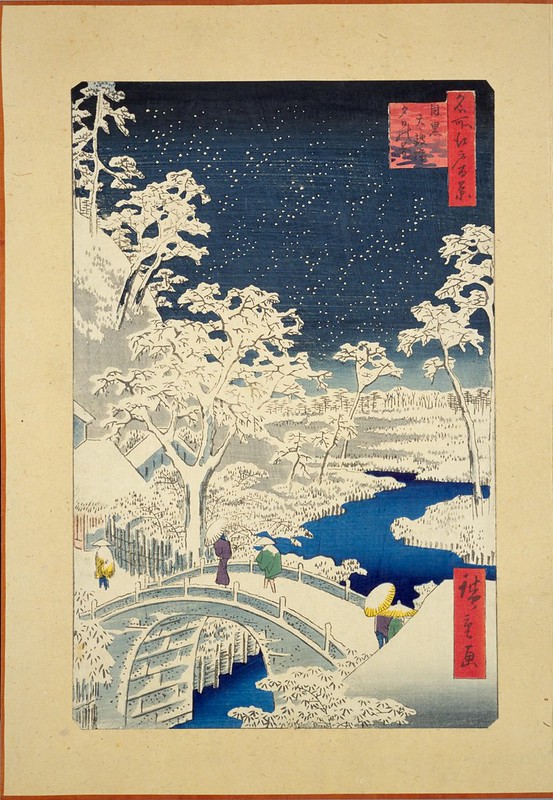
Meguro Drum Bridge and Sunset Hill
"Of the two attractions mentioned in the title, the Drum Bridge was the more celebrated site in the Meguro area. Arched bridges were unusual enough in Edo, but even more curious was a stone bridge, which offered few advantages in a city prone to earthquakes. Rounded forms and stone structures were more common in China than in Japan, suggesting a Chinese prototype for this bridge, although it is said to have been designed in the 1740s by a wandering priest inspired by a similar one in Kyushu, Japan. Hiroshige evokes a greater sense of isolation, even loneliness, in this snow scene by offering an oblique view. [..]
A view of the famous drum bridge in the valley of the Meguro River, the main route to the shrine of Meguro Fudo (not seen here and one of the few shrines not shown in this series). Arched, stone bridges were unusual in Edo, as they did not withstand earthquakes well, and this type of structure was more common in China than Japan. By 1919, this bridge was replaced by a steel structure, which although flat, does have an arch shape in the railings. On the left, the road leads up a steep slope known as Gyoninzaka, named after a wandering ascetic (gyonin) who founded the temple of Daienji on the side of the hill. The slope leading down from Meguro Station still survives today. The Sunset Hill of the title is shown at the left and was once known for its brilliant maple trees, although they had disappeared before this print was published. The hill has been the site of Gajoen, a large hotel and banquet palace, since 1931. This print portrays particular skill in depicting snow accumulation on the tree branches. The coming spring might be suggested by the use of green bokashi on the title cartouche." [
source]
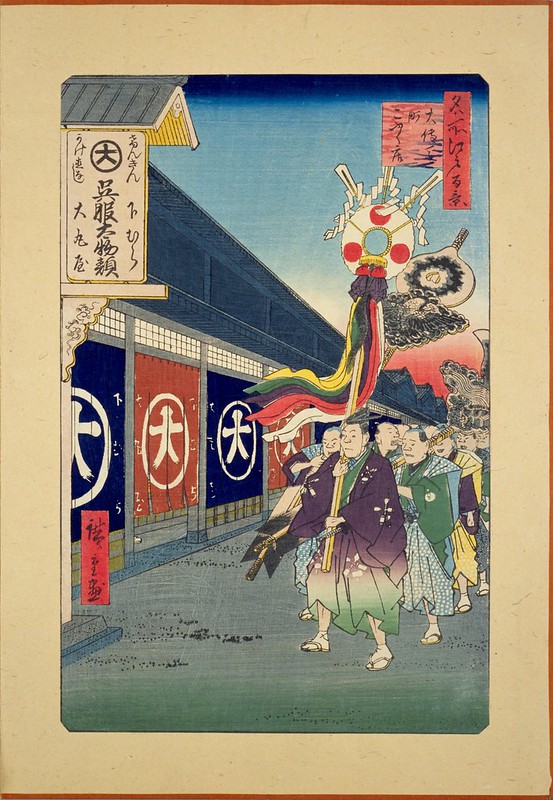
Silk Shops in Ōdenma-chō
"Here we see a boisterous procession of carpenters, among the most powerful artisans in Edo, a city built of wood. To the left is the great dry-goods house of Daimaru, in the prosperous district of Ōdenma-chō, suggesting the interlocked fortunes of Edo merchants and Edo builders. The shop sign to the upper left bears the slogan "Cash payment, prices as marked." This practice, established in Japan as early as 1683, broke down the traditional class-based relationships between seller and buyer, making all customers equal. [..]
This boisterous procession is called "sending off the master carpenter" (toryo-okuri) and it followed the ridgepole-raising ceremony for a new building. Since most of the structures in Edo were built of wood, fires were frequent, rebuilding was constant, and the carpenters were among the most powerful artisans in the city. The ceremony lasted several hours, beginning with rituals conducted by a Shinto priest on a platform atop the roof of the newly framed structure, on which the symbolic items, seen here on a pole, were displayed. This sacred pole has cloth strips of five colors, paper "gohei" above, in between three fans with the rising sun symbol surrounding a mirror, below women's hair accessories, said to be symbolic of the sacrifice of a young maiden at the beginning of a large building project. Next came two ceremonial "exorcising arrows," and on the arrows are mounted large carvings of the crane and the tortoise, symbols of long life. The chief carpenter is leading the procession and he is followed by the construction bosses, each in mock samurai ceremonial dress. After the rituals, the homeowner provided a banquet with plenty of drink. The marchers, seen with open mouths, are singing a work song. In this prosperous district of Odenma-cho, at left, is the well-known dry goods store Daimaru. The storefront of Daimaru is shown in careful detail, suggesting the idea of mutual prosperity. Daimaru was a branch of a Kyoto establishment, founded in 1717 by Shimomura Hikouemon (whose family name appears on the sign here) and expanded to Edo in 1743. The shop sign to the upper left says "cash payment prices as marked"; marking fixed prices on merchandise was a practice first established in Japan as early as 1683 and Daimaru followed competitively. It has been said that fixed pricing made all customers equal and that an egalitarian mass society had begun to emerge in Edo far earlier than anywhere else in the world. Today Daimaru continues to thrive at its new location, right over the east entrance of Tokyo Station." [
source]
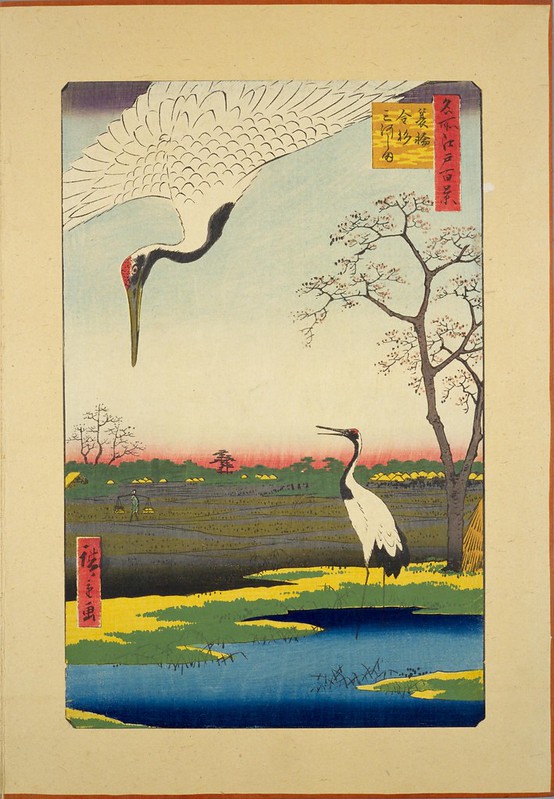
Minowa, Kanasugi and Mikawashima
"The title of this print lists three different villages northwest of the Yoshiwara pleasure quarters. The names that appear first probably represent the nearest places in the view. This would mean that it is a scene looking from Minowa and Kanasugi toward Mikawashima, to the west or northwest. Mikawashima was where the shogun's Crane Hunt occurred almost every year during the winter months, when cranes migrated to Japan. The auspicious nature of the crane made it an important ceremonial gift. Aside from the one or two birds taken on each hunt, the cranes of Mikawashima were carefully protected, as Hiroshige has depicted: the figure in the background is carrying buckets filled with rice with which to feed them. [..]
The title of this print lists the names of three different villages in an area northwest of the Yoshiwara and is most likely looking from Minowa and Kanasugi toward Mikawashima. Mikawashima is the site of the shogun's crane hunt in the winter, when cranes migrate to Japan. The shogun, in the company of seventy or eighty others, would release the first hawk; a crane was then captured and lashed to bamboo poles and taken to Kyoto to be presented to the emperor. Cranes were considered extremely auspicious birds, and yet they were hunted and eaten, at least on this special occasion. The crane shown here is the Japanese crane, called "tancho," or "red-crest" after the bald red spot on its head. Today only a few hundred of these protected birds survive in eastern Hokkaido. The tancho has pure white feathers, depicted by a blind-printed pattern on the backs of the birds; the blackening near the shoulders of the upper bird might be from the effects of the atmosphere on white lead pigment." [
source]


 Группа исследователей из Стэнфордского университета разработала и создала
Группа исследователей из Стэнфордского университета разработала и создала 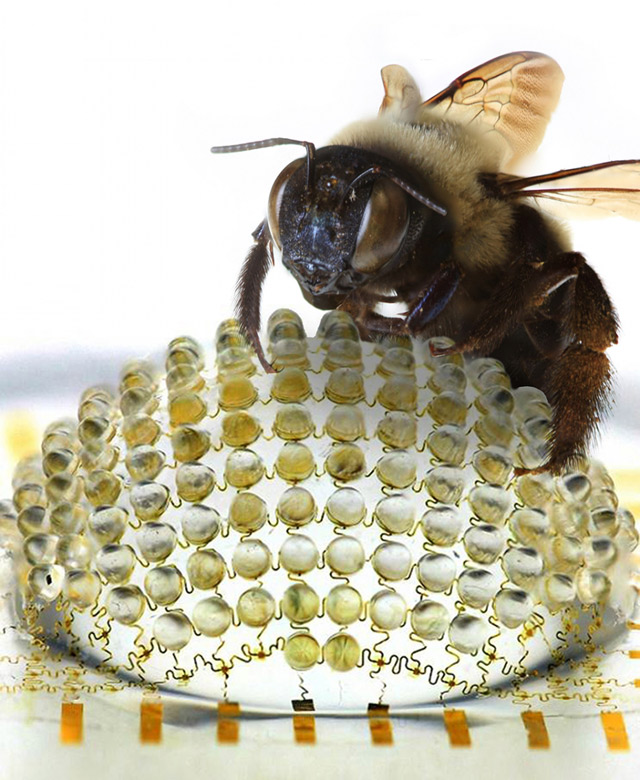

















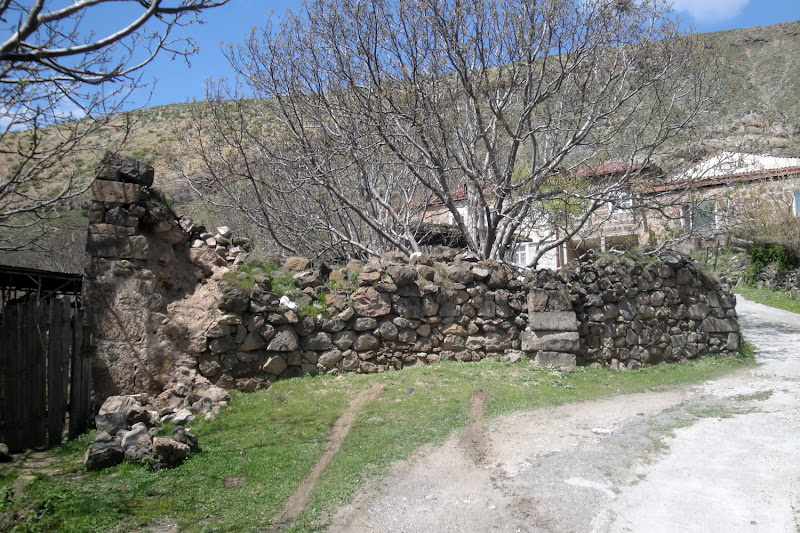


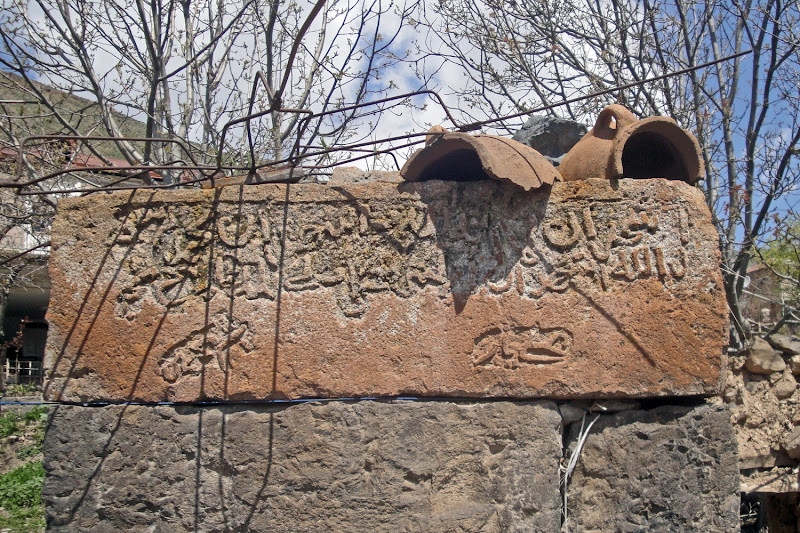
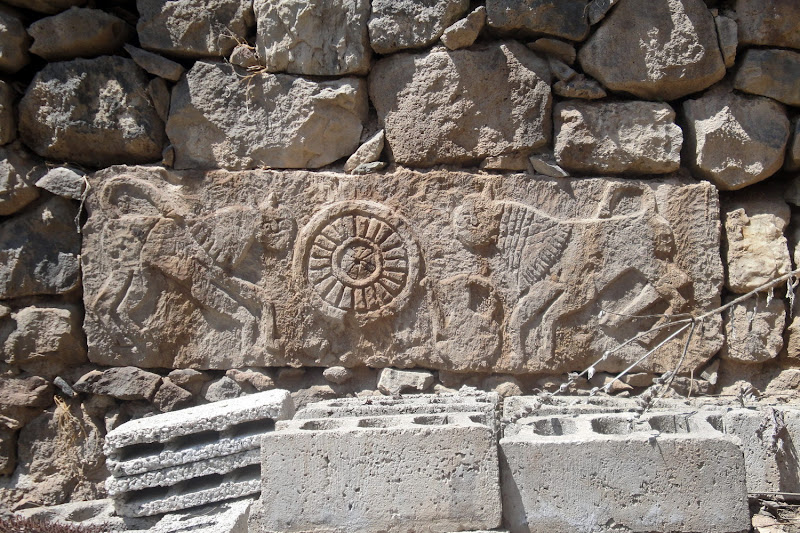


























































































 Физик Дмитрий Паращук о потенциале гелиоэнергетики, органических полупроводниках и солнечных батареях из полимеров
Физик Дмитрий Паращук о потенциале гелиоэнергетики, органических полупроводниках и солнечных батареях из полимеров







































